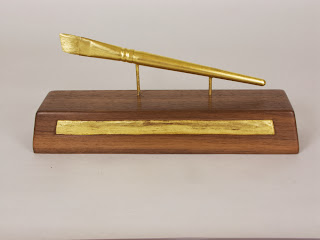12/22/13
Poplar, which is not a poplar.
Above a freshly cut piece of wood that had been outside. It is what in lumber yards would be called Poplar, white or yellow, though it is actually a Tulip tree. It is also called Popple. Normal color is white or green as the example above shows, turning brown upon exposure. Sometimes a fresh cut will reveal a variety of colors, purple, red, black; from mineral staining. Called Rainbow Poplar when so colored.
A good choice for moldings to be painted, as in architecture; not used that much in framing. The piece above came from a scrap pallet that was mostly oak, destined for the wood stove/fireplace, when I saw the green. Also used as a secondary wood in furniture, where it can also be used as the primary, stained and finished as cherry.
The botanist's identification of wood is often at odds with the lumberman's.
Odds and ends.
A corner of the studio. Most of my painting is done at the small drafting table, though there is an upright easel, that is affixed to the wall.
The easel with one panel of a tryptic having some of it's gilding touched up. The table to the right has an automobile jack as a lifting mechanism. Hanging on the left side of the easel, a leather bag that usually has my watercolor kit in it.
A small commission of two awards I designed and manufactured. Top, mahogany, bottom, black walnut with a carved and gilt panel. The bottom is waiting for it's name plate
12/15/13
Pocket Cameras addenda.
The two pocket cameras. On the left, the tiny Elph 110HS, and the bigger S110. The Elph is sporting a camera grip from Flipbac, which does improve it's "grippability". I'm trying the grip on the new camera for awhile; so far it does add to the ability to one hand, hold the camera.
Two things of some import: the larger camera has the tripod socket centered on the lens, which helps if you are doing tripod aided panoramas. Far more important to me is that both cameras have a self contained lens cap. Lens caps are ... a ... PITA. Even if you 99 percent of the time put the damn thing in the same pocket, ... well sometimes you don't, and you can't find it. And, they have the despicable habit of coming off during transport. And, if it stays on, you have to stop and remove it, put it somewhere, and then take the picture. PITA, cause when Elvis does walk by, he's not waiting for you to fumble around trying to get your camera to work.
I routinely paint out the garish white paint, or silver that Canon uses, to announce what brand of camera being used. Just me.
12/14/13
New pocket tool, and a failed experiment.
About a year ago I tried an experiment, going to a completely automatic camera as my pocket tool. Not exactly a failure, though I found it's limitations limiting. Ultimately it's greatest quality was it's tiny size, though because of the smoothness of it's body it required the addition of a small silicone handle, partially defeating the size.
Well, I've gone to a slightly larger machine, the Canon S110. Real camera controls if one desires, shoots in RAW, which I do, and holdable in one hand due to the sandpaper like texture of the outer case, along with an actual thumb grip on the back. Lot's of reviews on the interwebs.
The RAW advantage allows me to control the image rather than the camera doing it, and is really neither more complicated or time consuming, until you want to "save" an image.
The S110 is selling for an attractive price right now; Amazon has it for $219.00, and was adding a 16 GB class 10 SD card. Very good deal, as the previous S series, the S100 is selling used, for only a little less. (link to Amazon on the right, hint hint) This may be due to some bad reviews on some new features in this model. The S100 had GPS for geotagging photo locations. The S110 loses GPS, implementing a complicated Wi-Fi, that if one is so inclined, will allow the use of a smart phone to provide the geotagging. The new Wi-Fi can also be used to move photos around. I am, completely uninterested in either feature. So, no big deal. If I want to show somebody a photo, I have a smart phone that does that very well, and takes quite nice pictures, and I can tell from the photo where I was most of the time. Ehh.
Now, the camera itself, is an "enthusiast" machine, with a slightly larger sensor than most small cameras, and the complete range of manual controls. The S series, and the larger G series, are Canon's top level compacts. The photo of my dusty S110 (it's a pocket camera) was taken with my elderly G9.
As a pocket camera, in spite of all the manual controls, my machine is set for program, auto ISO up to 1600. It is possible to get usable images in available darkness, and compared to the "crap" we got with film; it's a wonderment. There is a customizable button that I have set to access the self timer; when I have time I'll punch that for a 1 second delay after releasing the shutter to minimize any movement. The ring around the lens is customizable also; mine is set for exposure compensation.
Three working cameras; the iPhone 4s, takes quite nice pictures within it's limitations, and I can message them instantly, and I can even work on them in the phone. I've taken some keepers with the iPhones, but sometimes, I want more. The S110 gives me a lot of control, or pretty much auto; it does have the green auto setting, JPG only, and scene settings, but I prefer RAW. And then, my venerable G9, my studio, big machine. A lot of the photos on this blog have been done with the G9, using either studio lights or flash, with the camera flash firing an old Nikon Speedlight. I can also fire the Nikon flash directly from the camera with a neutered Nikon cable. And all of them are not current generation machines; I'm quite comfortable being well behind the cutting edge. Image quality only matters if the image isn't saying much.
Subscribe to:
Posts (Atom)












